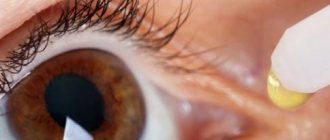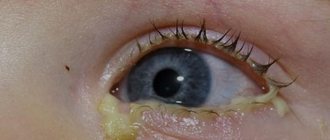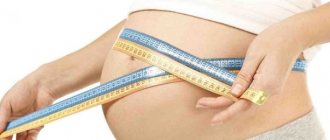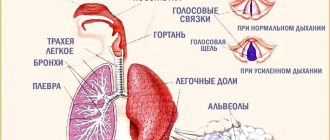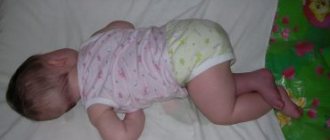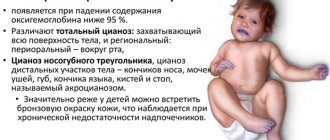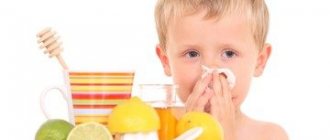Signs of dacryocystitis in children
In most children, the fetal membrane in the nasolacrimal duct (or gelatinous plug) most often bursts after birth, or resolves on its own within two to three weeks without the need for any treatment. But in cases where this did not happen, as a rule, at about two months of age (and sometimes already in the maternity hospital), the first symptoms of dacryocystitis appear:
- the baby's eye waters (lacrimation);
- lacrimation;
- redness and peeling of the skin of the cheeks due to constant flowing tears;
- increased lacrimation in cold and windy conditions;
- eyelashes sticking together after sleep;
- mucopurulent discharge in the inner corners of the eyes;
- when you press on the area of the lacrimal sac, pus is released from the lacrimal punctum (the hole in the inner corner of the eye);
- The sclera (white of the eye) is usually normal in color, but can sometimes be a little red.
The first thing to do if a newborn has a watery eye is to consult a doctor for an accurate diagnosis. The sooner a specialist can identify and begin to treat dacryocystitis, the easier and faster the recovery will come.
Complications
Sometimes, with a watery eye, parents begin treatment on their own - they rinse with antiseptics or tea leaves, and instill albucid. This brings a temporary effect, but does not solve the problem
If these points are not brought to the attention of a specialist at the appropriate time, serious complications may arise:
- redness and swelling of the eyelids;
- a painful, red lump near the inner corner of the eye;
- increased body temperature;
- poor appetite, sleep disturbances and anxiety;
- fistula on the lacrimal sac;
- phlegmon (diffused purulent inflammation);
- orbital cellulitis (life-threatening inflammation of the tissues surrounding the eye).
Test Vesta
If a newborn's eyes are watery, the doctor may prescribe a Vesta test to assess the patency of the nasolacrimal duct. To do this, a special dye (collargol, fluorescein) is dropped into the baby’s eye and the speed of fluid movement through the lacrimal ducts is assessed. First, the doctor looks at how quickly the fluid leaves the eye into the nasolacrimal duct (normally no more than 5 minutes). At the same time, a cotton turunda is introduced into the nasal cavity, which should be colored after about 7 minutes by the substance entering the nose. If staining occurs later than 10 minutes, we speak of a weakly positive West test. If the turunda is not colored at all, then the test is negative and treatment must begin.
The child's eye is red
If a child's eye is red, the cause may be conjunctivitis. This disease occurs differently in children than in adults. If a child gets conjunctivitis at a very early age, he may experience sleep and appetite disturbances, become capricious and not even play with his favorite toys.
The main signs of conjunctivitis in a child are the following:
- In the morning, the eyelids are glued together and a yellow crust forms on them;
- The child reacts too strongly to light;
- Pus may leak from the eye;
- If you pull back the lower eyelid, you can see redness and swelling;
- If the child can already speak, he will complain of a burning sensation and a feeling of discomfort in the eye (foreign body sensation), and visual acuity and clarity may also decrease.
This disease is especially acute before the age of 7 years. Since children should never be treated on their own, if symptoms of conjunctivitis or other eye problems appear in a child, you should immediately consult a doctor. But if for some reason it is not possible to immediately see a doctor, then you can provide first aid to your child. Using cotton swabs soaked in a warm chamomile solution, it is necessary to remove crusts from the eyelids every hour or several. Only a doctor can prescribe treatment for conjunctivitis!
Adenoviral conjunctivitis. It is accompanied by fever, headaches and loss of appetite, followed by reddening of the eyes. The lymph nodes may also become enlarged, your throat may begin to hurt and you may have a runny nose. This type of conjunctivitis is treated by instilling interferon or poludan into the eyes. You can also apply 0.25% tebrofen or florenal ointment to the lower eyelid.
Herpetic conjunctivitis. Herpetic conjunctivitis is also quite common in children. Symptoms of the disease are the appearance of vesicles (bubbles) or even pustules (bubbles with pus) around the eyes and on the edges of the eyelids. The eyes will water, and the child will be sensitive to light. This type of conjunctivitis is treated with antiherpetic drugs, for example, acyclovir, which the doctor will prescribe for use topically or orally.
Features of treatment
If any changes occur in the child’s eyes, you should immediately contact an ophthalmologist. Indeed, among the causes of red eyes in children there may even be simply an eyelash, sand or other small foreign object that has gotten there.
You should not put blindfolds on your child's eyes, as this will only create favorable conditions for the infection to spread through the membranes of the eye (warmth and humidity). If the infection spreads, keratitis can occur, which can cause vision loss.
Author of the article: Marina Vitalievna Degtyareva, ophthalmologist, ophthalmologist
Main causes of watery eyes in babies
Among the emotional factors that cause a newborn's eyes to water in the first months of life, crying occupies the main place. To them, the toddler signals hunger, pain and fear. If the baby’s psychological state is normal, but tearfulness is present, you need to look for other reasons; they are most likely related to health.
Factors of tearfulness in babies
| Cause | Peculiarities |
| Foreign body | In this case, the child has watery eyes. The following can get into it: • animal hair; • a hair from a person's head; • eyelash; • a speck blown by the wind; • small insect. Foreign bodies irritate the eyeball, causing discomfort (sometimes pain) in the baby. |
| Eye injuries | Tear ducts can be damaged not only by a foreign body, but also by drops of a chemical that accidentally enter the baby’s eye and cause a burn. You can also injure an apple by improperly washing the eyes. |
| Allergic reactions | If the baby’s body considers that the product eaten by him or the nursing mother is harmful, an allergic reaction will occur, one of the symptoms of which is tears. Their appearance is also provoked by certain odors inhaled by the baby. |
| Colds | If a baby has an acute respiratory viral infection, accompanied by rhinitis, when sneezing, not only snot will flow from the nostrils, but also salty liquid from the eyes. |
| Inflammatory processes | When tearfulness is accompanied by purulent discharge, an infectious disease may be suspected in the child: conjunctivitis, blepharitis, scleritis, inflammation of the nasal cavity, paranasal sinuses, etc. |
| Ophthalmological problems | Constant lacrimation in a child is usually associated with eye pathologies: • ptosis; • inversion or inversion of the eyelid; • corneal degeneration; • congenital cataracts; • abnormalities of the lacrimal ducts. In 2-6 month old babies, the cause of impaired lacrimal drainage may be an embryonic film that closes the ducts. |
| Dry eye syndrome | Eyes may become watery due to insufficient hydration. This is due to: • dry indoor air; • diseases that impair the quality of tear fluid (blepharitis, diabetes); • a number of medications. |
Eye itching
One-year-olds and older children may have watery eyes for the following reasons:
- as a protective reaction during temperature changes;
- formation of the upper row of teeth;
- pathologies of the nervous system;
- neoplasms of the paranasal sinuses;
- papillomas, cysts formed in the eye area;
- a tumor affecting the pituitary gland.
Single tears do not cause concern, since the basis is a protective physiological function. If the process has become protracted, and one of the baby’s eyes is watering, it is necessary to look for the cause of the phenomenon.
Note! Frequent lacrimation washes away beneficial microflora, which leads to the development of dangerous inflammations
Prevention methods
It is impossible to avoid the development of dacryocystitis, since you cannot influence the rupture of the protective film in any way. But massage and regular eye washing will help avoid serious complications.
But you are quite capable of preventing the development of viral and bacterial infections:
- every day, carry out hygiene procedures 2-3 times, in the first month it is better to rinse your eyes with saline solution or a weak solution of Furacilin, then you can use ordinary boiled water;
- do not touch the baby’s face with dirty hands;
- If you have a cold, be sure to wear a gauze bandage before feeding and interacting with your baby.
The best way to avoid infectious pathologies is to strengthen the immune system early and regularly.
Air and sun baths, daily gymnastics are beneficial for babies; be sure to maintain the temperature in the room within 18-22 degrees, humidity - 50-70%.
How can you help if your baby's eyes are watery?
Depending on the cause of abnormal tearing, your doctor may recommend:
- washing with disinfectant solutions in the appropriate dosage (dacryocystitis and conjunctivitis);
- disinfection of inflamed surfaces with ointments that relieve swelling and itching;
- drops identical to the natural composition of tears with an antibacterial effect. Remember that infants at 1 month, 3 months, six months and a year need different dosages and active substances in the drug, so follow the pediatrician’s prescription;
- anti-eczema creams that minimize skin dryness and restore its natural elasticity;
- drugs that lower histamine levels, anti-allergenic drugs are extremely rarely prescribed to children under 12 months, independent use is strictly contraindicated;
In addition to medications, a baby’s tears will help remove:
- Massage every 3 hours. Using circular movements from the cheekbones to the eyebrows, it is easy to massage the baby's face. Such actions calm the child, and stroking and pressing help strengthen the subcutaneous vessels and contribute to the rapid release of the infectious focus to the outside, where it is easier to eliminate it by washing.
- Folk remedies (only after discussion with your doctor!). Anti-inflammatory and aseptic decoctions can be prepared from chamomile flowers, caraway seeds, and red rose petals. You can use the resulting products to wash the newborn’s eyes 2-3 times a day, preferably after waking up. It is not recommended to take decoctions internally; this can lead to diarrhea and problems with the baby’s intestines.
Folk remedies
Traditional medicine recipes help remove swelling on the eyelids, reduce inflammation and redness, and have an antiseptic and antibacterial effect.
Anti-inflammatory decoction of calendula flowers
Place 1 tbsp in a small enamel container. l. calendula flowers and pour 450 ml of boiling water. Simmer the broth over low heat for 7 minutes, cool, strain. The product is suitable for compresses and rinsing. Do the manipulations 4 times a day, alternating lotions with eye irrigation.
Black tea compresses
Compresses with black tea effectively relieve symptoms of suppuration. Brew 1 tsp in 1/2 cup boiling water. large-leaf black tea (without flavorings, dyes), infuse and pass through 2-3 layers of gauze. Soak cotton pads in the infusion and apply to eyes for 5 minutes. Do the procedure up to 6 times a day.
Series
Place 1 tsp in 200 ml of boiling water. chopped herbs and boil for 3 minutes, let cool. Wash your eyes with the decoction in the morning and evening for 3 days.
Celandine decoction
Wipe your eyes with a decoction of celandine several times a day. Pour 200 ml of boiling water over the crushed flowers and leaves of the plant (1 tsp) and boil in a water bath for 5 minutes. Use the warm, strained decoction to rub the eyes 3 times a day.
Compress with essential oils
Soak a towel in hot water and drop 3-5 drops of lavender, rose and chamomile oil on it. Place the compress on your eyes and keep it until it cools completely. Manipulations are carried out 2 times a day. The product relieves swelling and inflammation, soothes irritated tissues.
Potatoes for inflammation
Potato compresses are an effective anti-inflammatory remedy. Peel 1 potato, grate on a fine grater, place on cheesecloth and place over the eyes. Keep the compresses for 10-15 minutes, then wash the child with calendula decoction or warm boiled water.
Rose hip decoction
Grind the dried rose hips to make 2 tsp. raw materials, pour 400 ml of boiling water and simmer for 10 minutes over low heat. Wash the child’s eyes with the broth up to 5 times a day.
Aloe juice drops
Place drops of aloe juice into your eyes 3 times a day. Grind the aloe leaf, squeeze out the juice, mix with warm water or saline in a 1:1 ratio. Apply 1 drop 3 times a day.
Honey drops
Dilute honey in warm water (1 teaspoon of honey per 3 tablespoons of water). Apply 1-2 drops to eyes three times a day. The product is used for children over 3 years of age.
It is possible to quickly and effectively cure a child at home if the therapy is carried out correctly, alternating rinsing with drops and lotions. The basis of treatment is medications, and traditional methods help enhance their therapeutic effect and alleviate the condition of the little patient.
Directions of treatment
First aid
When a newborn’s eyes fester, you should definitely consult a doctor.
But parents can provide first aid. It consists of removing pus and washing the mucous membrane with solutions with antiseptic and anti-inflammatory properties. It is important to treat both eyes to prevent the spread of infection
Solutions options:
- From plants - chamomile, calendula or black tea. Pour 1-1.5 tablespoons of raw material with a glass of boiling water. Leave for 1 hour. Filter.
- From furatsilin. Dissolve 1 tablet in 100 ml of boiling water. Cool.
- From Miramistin. Dilute the solution with water in a 50/50 ratio.
Processing algorithm:
- Make sure the solution temperature is close to body temperature.
- Soak a cotton pad or piece of bandage in the liquid.
- Rub the eye from the outer corner to the inner.
- Take a clean disk and repeat all manipulations with the second eye.
You should wash your eyes every 2 hours. It is advisable to prepare the cleaning solution before use.
There is an opinion that in a situation where a newborn’s eye begins to fester, breast milk should be instilled into it. This cannot be done. Despite all the benefits of milk, it is a favorable environment for the growth of bacteria and can increase inflammation and discomfort.
If allergic conjunctivitis is suspected, it is necessary to exclude the child from contact with a possible irritant: remove plants, soft toys, carpets from his room, and keep animals away. Frequent wet cleaning and regular ventilation are necessary. The same measures are appropriate for any inflammation.
Relieving inflammation
To effectively treat sour eyes, it is necessary to determine the causative agent of the disease. The most accurate method is bacterial culture of secretions from the lacrimal canals. But often doctors focus on external signs.
If the inflammation is caused by a virus, then drops with an antiviral effect are prescribed: Actipol, Poludan, Trifluridine. In addition, ophthalmic ointments can be used - oxolinic, Tebrofenovaya, Bonafton. In mild cases, it is enough to wash the eyes with antiseptic solutions and instill drugs with interferon, for example, Ophthalmoferon.
For bacterial inflammation, local antibacterial drugs are necessary. The most popular eye drops for newborns are Albucid. In addition, chloramphenicol (0.25%), gentamicin (0.3%), ciloxan (0.3%), tsifran (0.3%) and other antibiotics in the form of drops are used. Ointments can be prescribed - tetracycline, chloramphenicol. Systemic antibiotics in the form of tablets or injections in infancy are used only in severe cases, for example, with blennorrhea.
General treatment plan:
- Lay the baby horizontally without a pillow. Wash his eyes with an antiseptic solution.
- Warm the bottle with drops in your hands.
- Pull back the lower eyelid and drop the required amount of medicine using a pipette with a rounded end. It's good if someone holds the child's head.
- Remove excess drug with a clean napkin.
Usually the medicine needs to be injected into the conjunctival sac 3-4 times a day. The ointment is applied 1-2 times. To do this, move back the lower eyelid and squeeze a thin strip onto its inner surface.
Features of treatment for dacryocystitis
With dacryocystitis, it is important not only to destroy the pathogenic flora, but also to eliminate the cause of the disease - blockage of the duct. The easiest way is to massage the tear duct
Parents can conduct it themselves after training. It involves stroking movements with the thumb from the outer edge of the eyebrow, along its line, near the bridge of the nose, to the wings of the nose and in the opposite direction. Manipulations should be carried out with light pressure, but so that the child does not hurt. Frequency – 6-8 times a day.
If the massage does not lead to the removal of the “plug,” then the child is placed in a hospital and the lacrimal canal is cleaned (bougienage) under local anesthesia using a catheter. The procedure is painless. You should not refuse it, since without eliminating the blockage of the duct, attacks of dacryocystitis will be repeated, and adhesions will gradually form in the canal.
Causes of tears
If a baby under the age of 2 months or older has a watery eye, then this can be caused by a variety of factors:
- Colds. If the baby has a cold, often sneezes, or has a cough and runny nose, then the cause is a viral infection. Parents should definitely call a doctor who will examine the baby and prescribe the necessary treatment. When the cold is cured, the discharge from the eyes will also stop.
- Allergy. In this case, in addition to the fact that the child’s eyes constantly water, he will be capricious for any reason, he will develop snot, itching, irritation of the skin and mucous membranes. These signs may occur as a result of exposure to external factors or consumption of certain foods. To remove discharge from the eyes, you first need to eliminate exposure to the allergen.
- Eye damage. If a child’s eye waters, this can be caused by mechanical damage to the lacrimal canal, for example, during hygiene procedures. Also, one of the baby’s eyes may water if the baby falls and injures himself. After the necessary course of treatment is completed, the discharge will completely disappear.
- Foreign body in the eye. One of the child’s eyes is also watery because a grain of dirt, dust or an eyelash has gotten into it. You should not try to remove them yourself, as this can accidentally introduce an infection.
- Sudden temperature change. If you leave a warm room outside in cold weather, the body’s protective function is triggered, and the baby’s eyes become watery. This is a completely normal reaction, so there is no need to do anything.
- Abnormal development of tear ducts. In this case, the tear ducts will have a non-standard shape and will constantly become inflamed, causing the baby’s eye to water and fester. Cases of abnormal development include fistula, diverticulum and aplasia.
The reasons for the appearance of tears can be different.
A fistula is an opening (fistula) through which tears or pus are constantly released.
A diverticulum is a rare pathology in which the lacrimal sac bulges, which affects the discharge from the eye.
Aplasia is the absence of the lacrimal gland.
Conjunctivitis
But in addition to the fact that conjunctivitis causes increased lacrimation and photophobia, the child’s eyelids swell and he constantly rubs the reddened whites of his eyes.
To get rid of the disease, you should not self-medicate. Parents must definitely show the baby to the doctor, since another reason why a child’s eyes are watery is dacryocystitis. Its main difference from conjunctivitis is that with dacryocystitis, the baby has watery eyes in one eye, while with the second disease there may be discharge from both eyes.
Dacryocystitis
The main cause of the inflammatory process is the gelatinous plug, which is designed to prevent amniotic fluid from entering the baby's lungs when he is in the mother's womb.
As soon as the baby is born and makes its first sound, the plug breaks through and opens the tear duct, which gives tears the opportunity to wash the eyes and cleanse them of bacteria.
However, such a breakthrough does not always occur, and if a baby’s eye waters, it means that tears are stagnating in it. All this helps to create a favorable atmosphere for the development of bacteria, which causes acute dacryocystitis, which without treatment will become chronic. Therefore, if an infant’s eye is purulent, most likely the cause of this condition is dacryocystitis.
Attention! Knowing the causes of discharge from the eyes will allow parents to take the necessary measures in time by going with the baby to the doctor and without self-medicating.
When a newborn's eye waters, after an examination, the doctor can tell you what to do in such a situation and prescribe the necessary medications.
Surgical treatment
It is used in case of prolonged inflammation and complications that arise, when washing the eyes and using drops does not lead to recovery. Basically, such treatment is required if a newborn’s eye is watery, since the cause of his conjunctivitis may not be an allergy, or a virus, or bacteria. In 5% of cases, infants' eyes fester due to obstruction of the channel through which tears flow (this is prevented by a “gelatinous plug”), which is called dacryocystitis.
When treating dacryocystitis, the usual conservative methods are first used: washing the eyes, instilling them with anti-inflammatory drops, but in combination with massage of the lacrimal canal to open it and ensure the passage of tears.
Massage is necessary in all cases when a baby’s eyes become watery. It is done after feeding, pressing forcefully on the inner corner of the palpebral fissure and moving up and down. If purulent discharge is noticeable, then the actions are correct. Without massage, rinsing and using eye drops can smooth out inflammation, but over time the process of suppuration may repeat.
Conservative treatment of dacryocystitis is available to infants from 14 days to six months, after which it no longer makes sense. Later, when the newborn’s eye still waters, only an operation is prescribed - probing the lacrimal canal, during which the remnants of keratinized particles are forced out of it with a special probe.
It is important to know that any disease is easier to prevent than to cure. Therefore, careful observance of personal hygiene by the child will help prevent infection from getting into his eyes, and fortified nutrition will help him cope with it faster in the event of an inflammatory process.
Precautionary measures
Of course, parents cannot protect their children from any possible threat. However, you can follow certain recommendations to reduce your risk of developing conditions that lead to tearing.
Limit your child from sitting in front of a monitor screen. It is not recommended to spend time in front of the computer for more than an hour
There are also certain age restrictions. It is important to ensure you have the right diet. It is important that the child receives all the necessary vitamins and minerals, biologically active substances. Outdoor walks are recommended, even in bad weather. It is important to have adequate rest, sleep, and at least minimal activity and physical activity every day. Do eye exercises with your child
You can carry out general strengthening exercises by making circular movements with your eyes and blinking.
It is important to understand that if a child's eyes are watery, it is necessary to consult a doctor. The cause of this phenomenon may be serious diseases that require specialized treatment
Do not delay visiting a specialist, especially if you also experience accompanying alarming symptoms.
A baby's eye is watering: what to do about a watery eye in a 2 and 3 month old newborn
If lacrimation in a baby is not episodic, but persistent, you should consult a specialist even if there are no signs of inflammation and suppuration. A pediatric ophthalmologist will determine the cause of increased tearing and prescribe appropriate treatment, if necessary. Parents should firmly understand that the choice of method of therapy is the prerogative of the doctor, self-medication is in no case acceptable!
As therapeutic measures, depending on the cause that caused the symptom, the following may be proposed:
- washing the eyes for 2–3 days with a weak solution of furatsilin;
- prescription of anti-inflammatory non-steroidal and antibacterial drugs;
- prescription of antihistamines;
- rinses and compresses based on natural remedies - weak tea leaves, infusion of chamomile, sage or dill seeds (2 teaspoons per glass of boiling water);
- special massage of the lacrimal sac;
- surgical correction or probing of the lacrimal duct.
Rinsing the baby's eyes is done using a cotton pad.
The eye washing technique is very simple, any young mother can do it. The pre-prepared herbal infusion must be allowed to cool to body temperature (36–37 degrees), then strain. It is better not to soak the entire cotton pad in the solution, but to drip it onto it with a pipette. The direction of washing is from the outer corner of the eye to the inner.
A newborn's eyes may become watery. This happens especially often in children from one to three months. But lacrimation is not always a pathology. In each specific case, lacrimation can be caused by different reasons. Sometimes both eyes of a baby water, but it often happens that one eye is fine, but tears are constantly flowing from the other.
You need to make sure that this is really regular tearing and not a one-time occurrence. This does not mean that a “lonely” tear should be left on children's eyelashes. You need to carefully remove tears from your eyelashes with a clean napkin or handkerchief.
It is necessary to note whether the appearance of tears recurs or not, and how often it occurs.
For example, when tears appear as a result of an allergy, it is enough to remove the source of the allergy away from the child. If your child gets sand in their eyes, rinsing the eyes can also help clear up any tearing problems.
If parents cannot determine the obvious reasons why their child’s eyes are watery, or initial measures at home do not help for a day or two, they should seek help from a specialist.
After identifying the “non-emotional” reasons for the child’s tears, the doctor (and only the doctor) will be able to give the necessary recommendations and prescribe the correct treatment.
Well, parents should know the following:
- pathologies of the structure and development of the lacrimal passages and canals are eliminated surgically;
- poor patency of the nasolacrimal ducts is eliminated using a probing procedure;
- removal of a foreign body from the lacrimal canals is carried out only in a medical institution with further appointment of eye rinsing for several days;
- injured tear ducts are restored after taking a course of anti-inflammatory and disinfectant drugs;
- Viral and infectious eye diseases are treated as prescribed by a doctor (drops, ointments, antibiotics).
Sometimes parents notice that their infant's eyes are watering for no apparent reason. If this phenomenon occurs rarely, then there is no reason to worry.
If a baby's eye is constantly watering, the cause may lie in dacryocystitis, conjunctivitis, or a systemic disease. Temperature changes and too dry air can provoke tearing from one or both eyes at once.
Why do my child’s eyes fester?
Conjunctivitis is an eye disease that affects both adults and children. Children with weakened immune systems most often suffer from conjunctivitis. When a child is healthy, his eyes are clear and clean. In case of conjunctivitis, the eyes begin to itch and pus appears. The causes of the disease are different, let's look at some of them.
Conjunctivitis in children can be bacterial, viral and allergic. The causative agents of the disease are microorganisms and viruses that can cause various diseases.
Viral conjunctivitis occurs with acute respiratory viral infections, acute respiratory infections, and influenza; bacterial - from the entry of various bacteria into the body, such as Streptococcus or Haemophilus influenzae. Allergic conjunctivitis develops due to allergies to pollen, odors, and dust. At the same time, the eyes itch, the eyelids become red, and viscous pus is released.
Viral and bacterial forms are contagious and transmitted by contact. The bacterial form is accompanied by profuse pus discharge, and both eyes are affected. In the viral form, there is a large amount of tearing and a small amount of pus, and one eye is initially affected. This is why a sick child is prohibited from attending kindergarten or school.
How to treat when a child’s eyes fester
Treatment procedures are accompanied by constant instillation, rinsing, and putting ointment in the eyes. It should be instilled very carefully, pulling back the lower eyelid, with a sterile pipette. For viral and bacterial forms, it is necessary to apply warm compresses to the eyes, use antiviral drugs, and rinse the eyes with a special salt solution. For allergic forms, cold compresses and tear drops are useful. Before instillation, it is advisable to rinse your eyes with a disinfectant solution. Eye treatment should be considered complete only if not only the disease itself, but also its cause is eliminated.
The risk of conjunctivitis can be reduced. To do this, you must follow the rules of personal hygiene, try not to touch your eyes with dirty hands, and use only your own towel and pillowcase. Walking in the fresh air and physical activity have a beneficial effect on the child. To boost your immunity you need to take vitamins. You should frequently ventilate the premises and do wet cleaning.
Among folk remedies, only lotions and eye washing with herbs and tea are acceptable for children, the concentration of which should be small so as not to cause allergies. For newborns, folk remedies for conjunctivitis are used after consultation with an ophthalmologist. If the eye of an infant is festered, it is recommended to rinse it with a cotton swab moistened with warm boiled water or weak tea.
Now the illness seems to be behind us and the children’s eyes have become clear again. But it is worth noting that this disease lasts for quite a long time and untreated conjunctivitis can become chronic, in which itching, burning, a feeling of sand behind the eyelids, photophobia, and eye fatigue are felt. Also, advanced conjunctivitis can lead to vision loss. Only an ophthalmologist will be able to determine whether the child is completely cured or not.
Prevention and treatment of abnormal tearing in infants
A common mistake made by young parents who listen to “experienced” grandmothers is to try to cure their baby on their own. Naturally, no one can prohibit such actions, but remember that in this case, mothers and fathers bear responsibility for the health of the child. If you do not want to treat the consequences, it is better to visit a doctor or call him at home at the first suspicion of a disease.
Preventive measures for watery eyes of a newborn are as follows:
- maintain sanitary conditions in the room where the newborn lives: daily removal of dust, wet cleaning;
- ensure that there are no pets in the room - their fur is a source of strong allergens that a fragile body cannot cope with;
- try to eliminate drafts - place the crib in a place where there are no gusts of air (away from windows and doors);
- All the baby's things should be his own, designed for his age, especially toys and hygiene items.
Tearing in newborns is often due to eye infection. To avoid this, parents should adhere to the following recommendations:
- Maintain good hygiene. Before feeding and changing your baby, wash your hands well with soap.
- Avoid contact of sick people with the newborn.
- Use a soft towel to dry your baby's face. It must be washed and ironed on both sides often.
If a newborn's eye is watering for several days in a row and the eyelid is swollen, it is worth seeing an ophthalmologist. Most likely, we are talking about dacryocystitis. Treatment of this disease is complex; the child needs to massage the tear ducts and drip the eyes with antibacterial drops.
Causes
Watery eyes can be caused by several reasons.
- Cold. In this case, along with tears, the child will develop a cough, runny nose, fever, and frequent sneezing. If you have such symptoms, you should consult a doctor who will prescribe the optimal treatment.
- Allergy. An allergic reaction also causes itching, irritability, and the child begins to be capricious. Allergies can be triggered not only by environmental influences, but also by the diet of a nursing mother. Babies under 1 month of age may experience a reaction to food in this way. Allergies can also be a reaction to the introduction of complementary foods in children under one year of age.
- Eczema. Accompanied by peeling and dryness of the eyelids, it is a complex form of an allergic reaction.
- An abnormality of the lacrimal canals in a baby is expressed by the presence of an inflammatory process - canaliculitis.
- Damage to the lacrimal canal that occurred when washing the baby's eyes.
- A foreign body entering the eye area can cause watery eyes and redness. In this case, only a traumatologist can remove the foreign object.
- A sharp change in temperature sometimes causes a normal eye reaction in the form of tearing. It mainly occurs when the temperature changes from warm to cold.
There are also pathological eye conditions that are dangerous to the baby’s health.
Conjunctivitis
If you have watery eyes, redness of the whites of the eyeballs and swelling of the eyelids, you should consult a doctor as soon as possible, as these symptoms are signs of conjunctivitis.
The disease is further characterized by the presence of pus in the corners of the eyes. The disease is dangerous not only because of the presence of infection, but also because of the high risk of developing photophobia, as the child experiences pain.
A baby can become infected with conjunctivitis if:
- he had direct contact with an infected person;
- the baby's eyes were rubbed with dirty hands;
- an infection got into the eyeball during labor.
Conjunctivitis is divided into several types, and the classification of this disease is based on the factor affecting the eye:
- autoimmune;
- allergic;
- bacterial;
- viral;
- chlamydial.
The most common form of the disease in infants is bacterial conjunctivitis, which can be caused by:
- staphylococci;
- gonococci;
- enterobacteria.
Dacryocystitis
In the area of the inner corners of the eye incisions there are tear ducts, which until the birth of the child are in a blocked state with the help of a protective membrane. During labor, this film breaks and the tear ducts open. If a failure occurs and the channels remain blocked, dacryocystitis develops, characterized by stagnation of tear fluid.
When an infection of various origins enters the eye, mucus is released, which causes lacrimation. The disease is characterized by the presence of pus and redness of the white of the eyeball. The symptoms of this disease are similar to those of conjunctivitis, but have their own peculiarity: with dacryocystitis, only one eye is affected.
Treatment methods
Careful hygiene of mother and child is imperative. You need to wash your baby's eyes several times a day with warm chamomile infusion and use antimicrobial drops.
A massage that should be shown to parents by a specialist helps a lot. It is needed for dacryocystitis to open and clean the tear duct.
Treatment of conjunctivitis
After the doctor confirms the diagnosis, he will prescribe the necessary medications or procedures. It could be:
- massage of the nasolacrimal duct area;
- treatment with chloramphenicol;
- washing the eyes with furatsilin, herbal decoctions.
Traditional Treatments
To alleviate the baby’s condition, you can use drops such as “Albucid”, “Sulfacyl-sodium”, “Ophthalmoferon”. They should be applied under the lower eyelid, after cleansing the eye of pus.
Some people prefer ointments such as tetracycline. Simple furatsilin also helps well. To do this, you need to dilute one tablet in a small amount of water and wipe your eyes with this solution.
| Before starting treatment, you should definitely consult a specialist. |
Folk remedies
Herbal formulations do an excellent job of relieving the symptoms of tearing in children. These are different decoctions that need to be used to wash the eyes, ointments and lotions. Chamomile or sage helps a lot. Calendula has long been used by our ancestors to wash the eyes of babies.
Decoction recipes
- Parsley should be wrapped in cheesecloth and placed in hot water for a few minutes. After cooling the broth, you need to blot sterile gauze and apply it to the baby’s eyes for 3-5 minutes.
- Having brewed strong tea, cool it and leave for 30 minutes. The compress is applied to the eyes for half an hour.
- Fresh rose hips, jasmine and clover need to be chopped and poured with boiling water for 20–30 minutes. The cake is lightly wrung out, wrapped in gauze and applied to the eye area.
- Chop burdock and calendula leaves, wrap in cloth and dip in boiling milk. After leaving for 10–15 minutes, squeeze out the compress and apply it to the baby’s eyes.
By washing with herbal decoctions several times a day, you can avoid viral infections and inflammation. It must be remembered that the decoctions must be sterile and carefully strained from suspensions and microscopic particles.
Nursing mothers can wipe their eyes with breast milk. But this method is only suitable for newborns; for three-month-old babies it is better to use other methods.
Massage of the lacrimal sac of the eye
Before the procedure, you need to prepare the child. Carefully remove all pus from the eyes. To do this, you need to wipe the eyes with a well-moistened disk in liquid (so that it drips) from the outer corner to the inner one.
During massage procedures, the child should lie on his back:
- gently squeeze the liquid out of the lacrimal sac;
- drip the furatsilin solution and remove the pus with a sterile swab;
- carry out massage movements.
To do this, you need to make jerking or vibrating movements with your fingers (from top to bottom), lightly pressing on the skin. You need to start from the inner corner of the eye. The massage procedure should consist of 10 pushing movements and one vibrating in the opposite direction (from bottom to top). Sliding movements should be performed quickly enough, 2 seconds each. for every pressure.
| Massage is done 5 to 10 times a day. If the ophthalmologist, after a re-examination, determines that the canal has opened, then the massage course can be gradually stopped. |
Probing
Due to poor-quality washing during treatment procedures, traumatic damage to the canals can occur, which often leads to their narrowing, change and subsequent overgrowth. If treatment does not produce results within several weeks, then you need to contact your doctor again, who may prescribe probing.
Probing is an operation that is performed under local anesthesia and almost always ends successfully.
Why does tearing appear before the age of one?
When babies under one year old have watery eyes, this is a headache for young parents, because at this time the baby’s body is so fragile and vulnerable that even the appearance of tears becomes a good reason to visit a doctor.
Attention! The appearance of tears from the eye of a newborn baby is mainly a manifestation of defects in tear production. The most common causes of defects:
The most common causes of defects:
Obstruction of the lacrimal canal - is formed due to a thin film in the lacrimal canal, which for some reason did not rupture during the birth of the child and leads to dacryocystitis (inflammation of the lacrimal canal due to stagnation of fluid).
The main signs of obstruction of the lacrimal canal are increased tearing of the baby's eyes, redness, sticking of eyelashes and the appearance of purulent discharge (dacryocystitis).
- Stenosis of the nasolacrimal duct is a violation of the location of the nasolacrimal duct or its structure, namely its narrowing, due to its chronic inflammation. The main symptoms are redness of the mucous membrane of the eye, tearing, the appearance of swelling near the lacrimal punctum and the discharge of pus and mucus from it.
- An anomaly in the structure of the nose is a pathology of the structure of the nasal bone and paranasal sinuses, which leads to disruption of the functions of the nasal cavity and puts pressure on the tear duct, blocking it. Fortunately, such pathologies are rare in medical practice. The main symptoms of an abnormality in the structure of the nose are tearing from the eye, redness, swelling near the eye, purulent discharge from the corners of the eyes and sticking of the eyelids.
- Rhinitis and sinusitis are pathologies in which the baby’s nasal mucosa becomes inflamed. But if rhinitis can be classified as a mild disease, then it is better not to delay with sinusitis, since with this disease not only the nasal mucosa becomes inflamed, but also the bone walls of the maxillary sinus, which can lead to the spread of pus to adjacent tissues and the brain.
Symptoms of rhinitis and sinusitis include watery eyes, a slight increase in the baby’s body temperature, dryness and burning of the nose, and in more advanced stages – mucopurulent discharge from the nose.
Injuries to the lacrimal canals - injuries or ruptures of the nasolacrimal canals or lacrimal sac.
As a result, structures are formed that cause blockage of the lacrimal ducts and fluid stagnation, resulting in the development of traumatic dacryocystitis.
The symptoms of the disease are extremely obvious - wounds and tears in the lacrimal sac and eyelid, inflammation, as well as damage to the inner wall of the orbit.
Changes in the microflora of the conjunctiva occur due to the influence of many factors, among which are personal hygiene rules, seasons, air quality, various manipulations with the mucous membrane (injuries, surgery, foreign bodies).
Such changes are the most common causes of tearing eyes in a baby, since a large number of bacteria enter the mucous membrane, disrupting the usual microflora, causing various types of inflammation and disease.
Why does my eye water?
The baby himself will not complain, he will not tell, because he is still small. But experts know for what reasons this symptom may occur.
Cold. If the baby suffers from tearfulness, plus he has a cough, a small child sneezes and suffers from a runny nose, the temperature is elevated, then the reason is precisely an acute respiratory infection. You should definitely contact a pediatrician who will examine and prescribe therapy. As the child begins to recover, the lacrimation will disappear. Allergy. The answer to the question of why a baby’s eye waters can be answered by saying that this is a manifestation of an allergic reaction. At the same time, the eye itches and itches. A highly specialized doctor will help you make an accurate diagnosis and find out exactly what the baby is reacting to. Such a reaction occurs not only under the influence of external factors, but also due to the diet of the nursing mother. Children from 1 month to 1 year old can also suffer from food causes. Eczema. This is a more complex form of allergy manifestation. Other symptoms include dry, flaky eyes. Canaliculitis. Occurs due to an abnormality of the tear ducts. And since the shape is incorrect, inflammation occurs, which also manifests itself as tearing. The tear duct is injured. And the reason is not that children rub their eyes carelessly with their hands.
Sometimes an overly caring and loving mother can wash the eyes so intensively that this will lead to careless damage to the canal and associated symptoms. Foreign body in the eye. A baby may suffer from watery eyes if an eyelash or a particle of dust gets into it
Then one eye of the baby becomes watery and red, and you begin to look for ways to independently remove the foreign body, but supermams.ru advises visiting the traumatology department. Temperature jump. If a child suddenly goes from warm to cold and vice versa, then lacrimation in this case is a normal reaction, protective, and then no specific intervention is required. It is important to provide the baby with normal conditions.
Why does a child's eyes water on the street?
Watery eyes outdoors can occur due to various reasons.
Allergy
Allergies, hay fever, seasonal or allergic rhinitis.
This phenomenon has many names, but the essence is the same - increased sensitivity of the body to certain substances, provoking negative physiological reactions, including lacrimation.
Whatever factor causes the allergy, it is important to remember a few rules:
- Allergy is not a contagious disease;
- only by eliminating the patient’s contact with the allergen can you cope with lacrimation, runny nose, loss of appetite and weight loss of the child;
- ENT diseases of the nose also need to be treated.
ARVI
In fact, in children with a cold (ARVI, ARI), as well as with sore throat, influenza and measles, the eyes water due to viral conjunctivitis. This phenomenon is explained by the fact that with any similar diseases inflammation of the mucous membranes occurs.
Along with watery eyes, a cold may be accompanied by red eyes, swollen eyelids, burning and itching. This is due to sinusitis, or inflammation of the paranasal or paranasal sinuses.
When they become inflamed, the nasal septum swells, which prevents the nose from naturally clearing phlegm and mucus.
This process provokes pressure on the tear duct and excessive lacrimation.
Important! First of all, it is necessary to cure the cold, and then begin treatment for viral conjunctivitis
Dacryocystitis
Alarming symptoms usually appear in the first week of a child’s life - pus, redness of the sclera, lacrimation. Sometimes the gelatinous plug resolves on its own two weeks after the onset of the disease without consequences for the body. If this does not happen, then dacryocystitis simply needs to be treated. Ignoring this phenomenon leads to the transition of the disease to the chronic stage.
Photo 1. Dacryocystitis in a small child. The area in the area of the nasolacrimal duct is inflamed and red, and there is purulent discharge.
Lack of nutrients and vitamins
Under such conditions, the organs of vision are unable to quickly adapt to bright light, wind and temperature changes and react by secreting tear fluid for protection.
Tears from reaction to cold
If your eyes water when leaving the house, then there is a phenomenon called an allergy to cold (one of the types of allergic conjunctivitis).
In these cases, when the body temperature drops, histamine is released, which has a vasodilating effect, and the channels through which tear fluid is supplied begin to work more actively, as a result of which uncontrolled tearing occurs.
The most likely causes of the symptom
So, should you be alarmed if your child begins to water in one or both eyes for no apparent reason? In many cases, this symptom can disappear as spontaneously as it appeared. Tears, for example, can be released in the cold or when the baby enters a warm room from a cold street
Moreover, if this phenomenon becomes protracted, parents need to pay attention to this, since such a symptom may indicate the presence of problems with the baby’s health
Colds and viral diseases
A child suffering from ARVI or influenza will certainly have watery eyes. Increased lacrimation in this case is accompanied by an increase in body temperature, runny nose and cough. Thus, the reason here lies on the surface.
When a child has ARVI or influenza, lacrimation is present along with the traditional symptoms of these ailments.
Allergic reaction
The immune response of the baby's body to allergens can most often be caused by certain foods if it is bottle-fed or complementary foods. Babies who feed only breast milk are also not immune to allergies if the nursing mother’s menu contains substances that cause a negative reaction in the child. In addition to the production of tears, this symptom is also often accompanied by a rash, runny nose, cough, peeling and itching of the eyelids.
In addition, allergic lacrimation in babies can be caused by pet hair, plant pollen, household dust, certain medications, etc.
Conjunctivitis
Inflammation of the conjunctiva is characterized by redness of the mucous membrane of the eye, a feeling of itching and discomfort in the eye, and photophobia. The child is restless and constantly tries to rub his eyes. After sleep, the eyelids can “sour,” that is, fester.
Unilateral conjunctivitis - there are signs of an inflammatory process
Typically, conjunctivitis begins in one eye, and then the second is involved in the process. The cause of inflammation can be a minor injury to the eye, which a baby can accidentally inflict on himself by scratching the cornea or mucous membrane with a nail while making unconscious movements with his hands.
With conjunctivitis, the child tries to rub his eyes, which aggravates the disease
Conjunctivitis - Dr. Komarovsky’s school: video
Foreign body
Active secretion of tears can be observed when small particles - specks, eyelashes and small insects - get into the eye. In this case, lacrimation will continue until the foreign body is washed out of the eye naturally or removed by a doctor. Under no circumstances should you try to remove it yourself, since inept actions can lead to eye injury.
Dacryocystitis
Dacryocystitis is an inflammation of the lacrimal sac that occurs as a result of disruption of the normal outflow of fluid, as a result of which the contents stagnate and the active proliferation of pathological microorganisms begins in it. Reasons leading to the development of pathology in infants:
- congenital anomalies of the lacrimal canal - narrowing, elongation, tortuosity, closure of the canal with embryonic film, etc.;
- traumatic damage to the canal during medical manipulations (washing, probing, etc.), resulting in the formation of adhesions.
Persistent suppuration of the eye in an infant may indicate the development of dacryocystitis
Advice from Dr. Komarovsky
Evgeniy Olegovich is an experienced doctor and host of the TV show “Doctor Komarovsky’s School.” The pediatrician has extensive experience in treating lacrimation in infants, so he advises:
When there is an inflammatory process in the lacrimal sac, it is important to restore the outflow of tears with a massage, otherwise the condition is fraught with infection. Massage manipulations help release stagnant fluid; Before probing, it is necessary to exclude diseases of the cornea and check the patency of the lacrimal canaliculi; If allergies develop with lacrimation, antihistamine drops should be used according to age - other medications should be postponed
In case of an acute allergic course, you should see a doctor who will prescribe medications for oral administration - oral or injection.
American scientists believe: if dacryocystitis does not go away by 6–10 months, probing cannot be avoided. Anesthesia - local or general - is selected taking into account the age of the child and at the discretion of the ophthalmologist. The procedure requires sterility, so the presence of the baby’s relatives during the operation is excluded.
Treatment
Treatment depends on the specific cause of your tearing. Therefore, the doctor must first conduct a thorough examination of the child. If your physician prescribes treatment without proper examination, try finding another doctor.
For inflammatory eye diseases, treatment is aimed at eliminating the infection. If the lacrimal opening is covered with a film, an incision is made or pierced with a sharp probe.
For any obstruction of the nasolacrimal duct, be sure to consult an otolaryngologist. Because with such a deviation you can do without surgical intervention. The doctor will prescribe conservative treatment by probing the nasolacrimal duct and then rinsing it.
